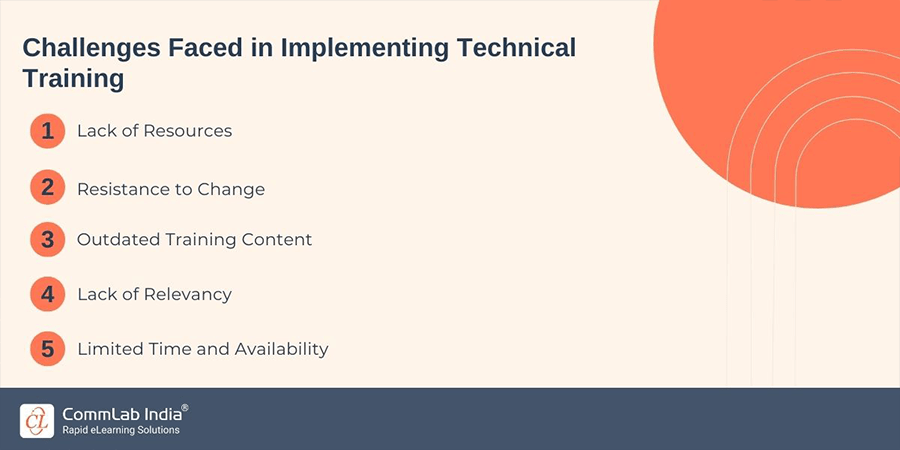What is the Role of Technical Training in Addressing Skills Gaps?
Wondering how technical training helps fill employee skill gaps? Read on to know...

Are you ready to unlock your team's full potential? In our ever-changing world, staying competitive means ensuring your employees have the right skills. But how do you bridge that skills gap effectively? That's where technical training comes in – it's a game-changer in learning and development. Join us as we explore how it plays a crucial role in filling those skill gaps and why investing in this transformative approach is the key to success for both individuals and organizations.
Why is it Important for L&D to Address Skill Gaps?
Addressing skill gaps through L&D is crucial as it empowers employees with the competencies essential for excelling in their roles, staying adaptable in a dynamic business landscape, and ultimately contributing to the overall success of the organization. It's a strategic investment in both individual growth and company prosperity.
In today's fast-paced world, businesses must stay competitive and adapt to changing market demands. That means having a highly skilled workforce that can keep up with new technologies and evolving business practices. But, there's a challenge – the skills gap, a mismatch between job role requirements and employee skills.

L&D covers all the efforts made by an organization to boost its employees' knowledge, skills, and abilities. These programs don't just benefit individuals; they also significantly impact a company's overall success.
L&D is vital for addressing skills gaps to -
- Fill Current Skill Gaps: Skills gaps occur when what employers need doesn't align with what employees possess. By investing in training programs that target areas where employees lack proficiency, organizations can bridge these gaps effectively.
- Prepare for Future Needs: With rapid technological advancements happening daily, new skill requirements constantly emerge in different industries. Continuous L&D initiatives help employees stay prepared for what's coming next.
What is the Role of Technical Training in Bridging Skills Gaps
Technical training equips individuals with practical, job-relevant knowledge and skills, contrasting traditional academic education. It readies individuals for real-world applications. The role of technical training in addressing skills gaps is pivotal, fulfilling the demand for specialized skills not readily available in the job market. It's hands-on, practical learning, allowing immediate application. These programs align with industry needs, enhancing employability. Flexibility, with customizable options, accommodates working professionals and those with commitments.
→ Download Now: A Practical Guide to Outsourcing eLearning Design & Development [eBook]
The benefits of incorporating technical training in L&D initiatives include -
1. Bridging Skills Gaps: Technical training in L&D is instrumental in closing skills gaps within organizations, especially in the face of rapidly advancing technology. It equips employees with specialized skills, helping them adapt to technological changes and filling any existing gaps.
2. Increased Efficiency: Technical training enhances workforce efficiency by providing advanced technological knowledge. When organizations introduce new software or tools, training on their effective use significantly boosts employee productivity, streamlines processes, and results in cost savings.
3. Stay Competitive: In the digital age, organizations must remain competitive by embracing the latest technologies and industry trends. Technical training empowers employees to acquire new skills and knowledge, enabling innovation and competitiveness.
4. Retaining Top Talent: Employees appreciate opportunities for growth and development. Offering technical training programs demonstrates a commitment to employee professional development, which can boost morale, motivation, and increase retention rates of top talent.
5. Improved Performance: Technical training equips employees with the knowledge and tools necessary for more effective job performance, enhancing their efficiency in technology-driven tasks or projects.
6. Foster a Culture of Continuous Learning: Incorporating technical training into L&D initiatives reinforces a culture of ongoing learning within organizations. This environment encourages employees to continuously upskill and stay relevant in their roles.
Here's a video to help you understand better
Challenges Faced in Implementing Technical Training (and How to Overcome Them)
Technical training plays a crucial role in bridging the skills gap and equipping employees with the necessary technical skills to excel in their roles. However, implementing technical training programs can come with its own set of challenges.
Let's discuss some common challenges faced in implementing technical training and ways to overcome them.

1. Lack of Resources: One of the biggest challenges faced by organizations when it comes to implementing technical training is a lack of resources. This includes both financial resources as well as human resources. Designing and delivering effective technical training programs requires a significant investment of time, money, and expertise.
Solution: To overcome this challenge, organizations can consider partnering with external training providers who specialize in technical training. This can help reduce costs while also providing access to expert trainers and resources. Additionally, leveraging eLearning platforms or utilizing internal subject matter experts for delivery can also be cost-effective solutions.
2. Resistance to Change: Another common challenge is resistance from employees towards learning new skills or processes. Employees may feel comfortable with their current level of knowledge and may resist investing time and effort into acquiring new technical skills.
Solution: To address this challenge, it is important for organizations to create awareness among employees about the benefits of upskilling through targeted communication strategies. Providing clear explanations about how the new skills will benefit not just the organization but also the individual's career growth can motivate employees to embrace change.
3. Outdated Training Content: Technical training programs need to be regularly updated to keep up with the constantly evolving industry trends and technologies. However, many organizations struggle with outdated training content that does not align with current industry practices.
Solution: To overcome this challenge, organizations should establish a process for regularly reviewing and updating their technical training materials. This can involve seeking feedback from employees, conducting research on industry trends, and collaborating with subject matter experts to ensure the training content remains relevant and up-to-date.
4. Lack of Relevancy: Technical training programs may not always address the specific needs of employees or the organization's objectives. This can result in a lack of engagement and relevance for the learners.
Solution: To make technical training more relevant, organizations should conduct a needs analysis to identify the skills gaps within their workforce. Based on this analysis, they can tailor their training programs to address specific skill deficiencies and align them with organizational goals.
5. Limited Time and Availability: Employees often have busy schedules and finding time for technical training may seem like a daunting task. This can lead to low attendance rates and hinder the impact of the training program.
Solution: To overcome this challenge, organizations can offer flexible learning options such as self-paced online courses or microlearning modules that employees can access at their convenience. Additionally, breaking down training into smaller, bite-sized modules can make it more manageable for employees to fit into their schedules.
Summing Up
In conclusion, implementing technical training programs is key to closing skill gaps and locking in sustainable growth. However, the implementation can be challenging, especially if the developing part becomes off! But worry not because you can always outsource your learning projects.
But the key is to select the right outsourcing partner and this eBook is here to help you.





